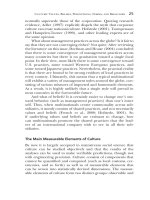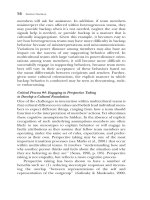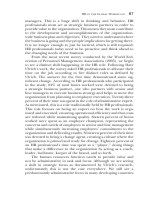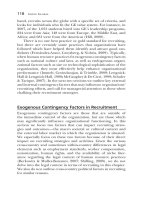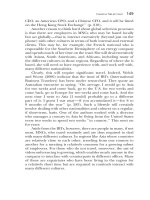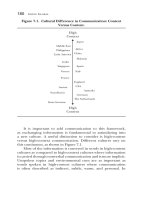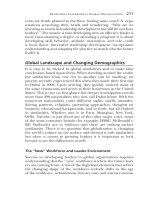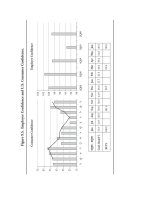Going Global Practical Applications and Recommendations for HR and OD Professionals in the Global Workplace J-B SIOP Professional Practice Series by Kyle Lundby, Jeffrey Jolton and Allen I. Kraut_1 ppt
Bạn đang xem bản rút gọn của tài liệu. Xem và tải ngay bản đầy đủ của tài liệu tại đây (872.25 KB, 28 trang )
Professional Practice
SERIES
THE
A Publication of the Society for
Industrial and Organizational Psychology
Going Global
Today’s global organizations operate at an
extraordinary level of complexity. They not only
contend with diverse languages, cultures, and political/
legal situations, they must also deal with differences
based on national boundaries, organizational size,
product and services mix, functional specialization,
and customer sets.
Going Global offers human resource professionals
and I/O psychologists a comprehensive resource for
meeting the challenges of the global work environment.
Edited by Kyle Lundby, along with Jeff Jolton and a
team of leading-edge practitioners, this comprehensive
volume uses the employee lifecycle as an underlying
framework and is organized into three sections:
• Practical considerations for HR and OD
practitioners in a global environment;
• Attracting and selecting global talent; and
• Maximizing performance in the global workplace.
Within each section, authors explore key cornerstones
of I/O practice (e.g., selection, leadership development)
applied to the global workplace.
Going Global outlines the best practices in the fi eld
and is fi lled with down-to-earth advice from those who
have worked in the fi eld. The book not only provides
insightful analysis of such broad topics as what it
means to be global and HR’s strategic role in global
organizations, it examines the undercurrent of culture
and its pervasive infl uence on organizations and the
people that comprise them. Going Global also contains
valuable information on global employee attraction,
selection, and retention strategies, as well as current
thinking about intercultural competence training, work-
family balance, and the expatriate experience.
The Editor
Kyle Lundby is a senior consultant with strong
business acumen and a proven track record of
supporting global organizations in their talent
management and organizational change efforts. He
has a Ph.D. in Industrial/Organizational Psychology
and has numerous publications and presentations
to his credit. Lundby recently returned to the United
States after completing a multi-year expatriate
assignment in Asia.
The Society for Industrial and Organizational
Psychology (SIOP) is a 7,000-member division
within APA. The Professional Practice Series provides
practitioners and students with guidance, insights,
and advice on how to apply the concepts, fi ndings,
methods, and tools from I/O psychology to solve
human-related organizational problems.
Going Global
Lundby
editor
Going Global doesn’t offer a one-size-fi ts-all approach
but rather includes many strategies and solutions
that can apply to a wide variety of situations and
organizations. Going Global offers fi rms a roadmap for
creating a winning program for international success.
Praise for
Going Global
(Continued from front flap)
Cover images © iStock
(Continued on back flap)
Kyle Lundby EDITOR
With Jeffrey Jolton
Going Global
Practical Applications and
Recommendations for HR
and OD Professionals in
the Global Workplace
“The very concept of globalization is evolving, and this book provides a
useful toolkit to those who want to capitalize on the opportunities that the
global workplace offers.”
—Wayne F. Cascio, Ph.D., editor, Journal of World Business, Robert H.
Reynolds Chair in Global Leadership, University of Colorado, Denver
“A very timely and useful look at the global workplace and how talent
should be managed in it.”
—Edward E. Lawler III, Distinguished Professor, University of Southern
California
“The time has long past when we, in organizational psychology, can
confi ne our research and practice to North American settings. This
book is timely and will provide an important resource for those who
are interested in the global application of our tools and principles.”
—Gary P. Latham, Secretary of State, Professor of Organizational
Behaviour, Rotman School of Management, University of Toronto
“A book that fi lls a gap: This is one of the rare books that provides HR
professionals with insights that are not only up to date from a technical
perspective but truly practical and relevant in a global workplace.”
—Michael Liley, partner and global HR director, Ernst & Young
www.josseybass.com
Join Us at
Josseybass.com
Register at www.josseybass.com/email
for more information on our publications,
authors, and to receive special offers.
ORGANIZATIONAL DEVELOPMENT
Going Global
The Professional Practice Series
The Professional Practice Series is sponsored by The Society for
Industrial and Organizational Psychology, Inc. (SIOP). The series was
launched in 1988 to provide industrial and organizational psychologists,
organizational scientists and practitioners, human resources
professionals, managers, executives and those interested in
organizational behavior and performance with volumes that are
insightful, current, informative, and relevant to organizational practice.
The volumes in the Professional Practice Series are guided by five tenets
designed to enhance future organizational practice:
1. Focus on practice, but grounded in science.
2. Translate organizational science into practice by generating guide-
lines, principles, and lessons learned that can shape and guide
practice.
3. Showcase the application of industrial and organizational psychology
to solve problems.
4. Document and demonstrate best industrial and organizational-based
practices.
5. Stimulate research needed to guide future organizational practice.
The volumes seek to inform those interested in practice with guidance,
insights, and advice on how to apply the concepts, findings, methods,
and tools derived from industrial and organizational psychology to solve
human-related organizational problems.
Previous Professional Practice Series volumes include:
Published by Jossey-Bass
Strategy-Driven Talent Management: A Leadership Imperative, Rob Silzer and
Ben E. Dowell, Editors
Performance Management, James W. Smither and Manuel London, Editors
Customer Service Delivery, Lawrence Fogli, Editor
Employment Discrimination Litigation, Frank J. Landy, Editor
The Brave New World of eHR, Hal G. Gueutal, Dianna L. Stone, Editors
Improving Learning Transfer in Organizations, Elwood F. Holton III,
Timothy T. Baldwin, Editors
Resizing the Organization, Kenneth P. De Meuse, Mitchell Lee Marks,
Editors
Implementing Organizational Interventions, Jerry W. Hedge, Elaine D.
Pulakos, Editors
Organization Development, Janine Waclawski, Allan H. Church, Editors
Creating, Implementing, and Managing Effective Training and Development,
Kurt Kraiger, Editor
The 21
st
Century Executive, Rob Silzer, Editor
Managing Selection in Changing Organizations, Jerard F. Kehoe, Editor
Evolving Practices in Human Resource Management, AllenI.Kraut,Abraham
K. Korman, Editors
Individual Psychological Assessment, Richard Jeanneret, Rob Silzer, Editors
Performance Appraisal, James W. Smither, Editor
Organizational Surveys, Allen I. Kraut, Editor
Employees, Careers, and Job Creating, Manuel London, Editor
Getting Action from Organizational Surveys, Allen Kraut
Published by Guilford Press
Diagnosis for Organizational Change, Ann Howard and Associates
Human Dilemmas in Work Organizations, Abraham K. Korman and
Associates
Diversity in the Workplace, Susan E. Jackson and Associates
Working with Organizations and Their People, Douglas W. Bray and Associates
Going Global
Practical Applications
and Recommendations
for HR and OD
Professionals in the
Global Workplace
Edited by Kyle Lundby
with Jeffrey Jolton
Foreword by Allen I. Kraut
Copyright © 2010 by John Wiley & Sons, Inc. All rights reserved.
Published by Jossey-Bass
A Wiley Imprint
989 Market Street, San Francisco, CA 94103-1741—www.josseybass.com
No part of this publication may be reproduced, stored in a retrieval system, or transmitted in any form
or by any means, electronic, mechanical, photocopying, recording, scanning, or otherwise, except as
permitted under Section 107 or 108 of the 1976 United States Copyright Act, without either the prior
written permission of the publisher, or authorizationthroughpaymentoftheappropriate per-copy fee
to the Copyright Clearance Center, Inc., 222 Rosewood Drive, Danvers, MA 01923, 978-750-8400, fax
978-646-8600, or on the Web at www.copyright.com. Requests to the publisher for permission should
be addressed to the Permissions Department, John Wiley & Sons, Inc., 111 River Street, Hoboken, NJ
07030, 201-748-6011, fax 201-748-6008, or online at www.wiley.com/go/permissions.
Readers should be aware that Internet Web sites offered as citations and/or sources for further
information may have changed or disappeared between the time this was written and when it is read.
Limit of Liability/Disclaimer of Warranty: While the publisher and author have used their best efforts
in preparing this book, they make no representations or warranties with respect to the accuracy or
completeness of the contents of this book and specifically disclaim any implied warranties of
merchantability or fitness for a particular purpose. No warranty may be created or extended by sales
representatives or written sales materials. The advice and strategies contained herein may not be
suitable for your situation. You should consult with a professional where appropriate. Neither the
publisher nor author shall be liable for any loss of profit or any other commercial damages, including
but not limited to special, incidental, consequential, or other damages.
Jossey-Bass books and products are available through most bookstores. To contact Jossey-Bass directly
call our Customer Care Department within the U.S. at 800-956-7739, outside the U.S. at 317-572-3986,
or fax 317-572-4002.
Jossey-Bass also publishes its books in a variety of electronic formats. Some content that appears in
print may not be available in electronic books.
Library of Congress Cataloging-in-Publication Data
Going global: practical applications and recommendations for HR and OD professionals in the global
workplace / edited by Kyle Lundby with Jeffrey Jolton; foreword by Allen I. Kraut. —1st ed.
p. cm. —(The professional practice series)
Includes bibliographical references and index.
ISBN 978-0-470-52533-3 (cloth)
1. Personnel management. 2. International business enterprises. 3. Globalization.
I. Lundby, Kyle M. (Kyle Martin) II. Jolton, Jeffrey
HF5549.G624 2010
658.3—dc22
2010003736
Printed in the United States of America
first edition
HB Printing 10987654321
PB Printing 10987654321
The Professional Practice Series
Series Editor
Allen I. Kraut, Baruch College/Kraut Associates
Editorial Board
Seymour Adler, Aon Consulting
Neil R. Anderson, University of Amsterdam
Neal M. Ashkanasy, University of Queensland
Lawrence Fogli, People Focus, Inc.
C. Harry Hui, University of Hong Kong
Elizabeth B. Kolmstetter, Director of National Intelligence
Kyle M. Lundby, Kenexa
Kathleen Kappy Lundquist, APT
William H. Macey, Valtera
Lise M. Saari, New York University
Table of Contents
Foreword xi
Allen Kraut
Preface xv
The Contributors xxiii
Part One: Practical Considerations for HR
and OD Practitioners Working Across
Geographic-Cultural Boundaries:
The Changing Workplace xxxv
1 Navigating the Complexities of a Global
Organization 1
Mariangela Battista, Patricia Pedigo,
and Erica Desrosiers
2 Culture: Values, Beliefs, Perceptions, Norms,
and Behaviors 22
Vesselin Blagoev
3 Multicultural Teams: Critical Team Processes
and Guidelines 46
C. Shawn Burke, Marissa L. Shuffler, Eduardo
Salas, and Michele Gelfand
4 HR in the Global Workplace 83
Mariangela Battista and Mario DiLoreto
Part Two: Attracting and Selecting Employees
in the Global Workplace 111
5 Recruitment in a Global Workplace 113
Mukta Kulkarni and Mathian Osicki
ix
x Contents
6 Global Selection: Selection in International
Contexts 143
Tim Carey, David Herst, and Wynne Chan
7 On-Boarding in a Global Workplace 175
Mary Plunkett
Part Three: Maximizing Performance in the
Global Workplace 201
8 Developing Leadership in Global Organizations 203
Tommy Weir
9 Strategic Surveying in the Global Marketplace
and the Role of Vitality Measures 231
Jeffrey M. Saltzman and Scott M. Brooks
10 Best Practices for Training Intercultural
Competence in Global Organizations 256
Jessica L. Wildman, Luiz F. Xavier, Mitch Tindall,
and Eduardo Salas
11 Creating Infectious Change in Global
Organizations: Applying Psychology to
Large-Scale Planned Interventions 301
Paul M. Mastrangelo
12 Maximizing the Success and Retention
of International Assignees 333
Paula Caligiuri and Thomas Hippler
13 Work and Family in a Global Context 377
Tammy D. Allen, Kristen M. Shockley,
and Andrew Biga
The Editor 403
Subject Index 405
Name Index 419
Foreword
This latest volume in the Professional Practice Series deals with
the practical impact of globalization on the work done by most
industrial-organizational psychologists and their human resource
management colleagues in many organizations around the world.
The effects of globalization are powerful and growing and are not
always well understood. This book will help readers to recognize
and deal with many of its important effects in the workplace.
We can easily recognize globalization in our everyday personal
and professional lives. The total of the United States’ imports and
exports from overseas has grown from less than 10% of the gross
national product in 1969 to more than 25% today. Our market-
places in the United States are full of products made abroad,
and the same is true in other nations. The overseas membership
of the Society for Industrial and Organizational Psychology,
which sponsors this book series, has doubled in the last 10 years
and now makes up more than one out of every eight members.
The less visible aspects of globalization include the different
cultures found in other nations, and how that impacts the way in
which we practice our professions. Sometimes, these differences
become known only when we start to work overseas or work with
people from other countries.
These realities, the need to understand what works elsewhere
and what does not, and the need to adjust our mental models and
actual behaviors are topics that resonate deeply for me. As a
college teacher, I have often told my American students that if
you really want to understand what it means to be an American
you have to travel and live elsewhere. That is when one begins to
understand what is different in other lands. It is sometimes said
that ‘‘the fish is the last to notice water.’’ Experience in other
countries makes it clearer just what assumptions, behaviors, and
values are different from your own.
xi
xii Foreword
My own interest was piqued by the frequent observations of my
European-born parents about how ‘‘things are done differently
in this country.’’ My awareness of differences in culture was
heightened when the U.S. Army gave me the ‘‘opportunity’’ to
live in the Far East for a year and a half. It grew when I was
later employed as the head of personnel research for the IBM
World Trade Corporation for four years, traveling and working
all around the globe, with a year off to teach at a Middle Eastern
university. During much of this time, my renowned IBM colleague,
Professor Geert Hofstede, was developing his landmark theories
of cultural differences.
Hofstede’s writing about the experience of living in and inter-
acting with people from a different culture than one’s own
includes references to the adventures (and misadventures) of
Alice in Lewis Carroll’s classic story of Alice in Wonderland. The
creatures she met and their behaviors were terribly different from
any that she knew; her experience illustrates how many people
feel when they venture overseas. A less mythical tale is found in
Democracy in America, the writings of the Frenchman Alexis de
Tocqueville based on his first visits to the United States in the
1830s. His trenchant observations of the American character, still
studied today, could only have been written by a visitor from
another country.
Similarly, the observations and accumulated wisdom of the
editors and contributors to this book are based on their work
overseas. Both Kyle Lundby and Jeffrey Jolton have had extensive
experience working in various countries. Moreover, they have
assembled an all-star cast of more than two dozen smart and well-
rounded organizational psychologists with experience overseas to
bring us up to date on useful ideas and practices out of the United
States. Much of their writings are based on global organizations,
not merely U.S. firms abroad.
Today’s global organizations operate at an extraordinary level
of complexity. Many have evolved from international firms with a
plant or two overseas, and have gone beyond a multinational stage
of having several similar firms in different countries to becom-
ing truly global firms with worldwide operations, interests, and
viewpoints. People in these global organizations cope with com-
plexities that go far beyond language and culture. They must also
Foreword xiii
deal with the differences based on national boundaries, organi-
zational size, product and services mix, functional specialization,
and customer sets (some of which are themselves global in reach).
People working in such firms must deal with a large array of
overlapping matrices of purpose and responsibility.
Our contributors’ chapters help us to understand how prac-
tices must be adapted to take account of such organizational
complexities. Their work will also will help us to tackle a question
raised by Hofstede forty years ago, when he asked ‘‘Do Ameri-
can theories apply abroad?’’ He concluded that they often do not
apply, or do so only partly. But the recent experience of this book’s
contributors suggests that they do, or at least that many of the prac-
tices based on those theories do reasonably well, when different
cultures are taken into account and adjustments are made.
Lundby and Jolton have done us all a great service by bringing
together a set of authors who give us useful input about the entire
life cycle of employees, ranging from recruiting to training and
development, to expatriate assignments, and much more. The
broad coverage in this volume will bring new understanding and
skills to a wide range of professionals in applied psychology
and human resource management.
This is the first volume under the current editorial board,
many of whom advised the book’s editors. It is especially fitting to
the topics in this book that three of the eleven members of the
boardarebasedoverseas.
The purpose of the Professional Practice Series is to bring
the best available knowledge and leading-edge practices, based
on solid theory and concepts, to practitioners and those entering
practice. The intent is to share the best of what we know and do in
order to guide the field and improve the overall level of practice.
I think that readers of this book will find that Lundby and Jolton,
along with their associates, have accomplished that mission very
well, with energy and great skill.
Allen I. Kraut, Series Editor
Baruch College, CUNY
Preface
What Is Global?
What does it really mean to be a ‘‘global organization’’? When
people talk about globalorganizations,they typically describe parts
of the whole, but not necessarily the whole itself. For example, an
organization may say ‘‘we’re global’’ because they have offices in
Europe or Asia as well as the United States, or because their final
product uses parts manufactured by affiliates in Brazil or South
Korea, or because they sell their products around the globe.
Yet successful global organizations are typically more than just
the sum of pieces scattered about the world. Their value comes
from interactions, processes, and opportunities that exist in a
unique combination that could not happen in a business working
in a single location or within the same general geography.
Merriam-Webster defines ‘‘global’’ as ‘‘relating to, or involving
the entire world’’ or ‘‘relating to, or applying to a whole.’’ Global,
then, refers to something that is universal, total, and inclusive.
From this whole, organizations can derive something more than if
they were operating as either separate or noninteracting entities.
There are at least four important components having to do
with structure and strategy that differentiate the nonglobal or
‘‘run-of-the-mill’’ multinationals from those that effectively lever-
age and capitalize upon their global footprint:
• Physical Dispersion: This is the most obvious and common differ-
entiator; a business that operates in multiple locations is very
different from a business with only one location. And an orga-
nization that operates in multiple countries across the globe is
different still.
xv
xvi Preface
• Diversity of Thought, People, Culture: Global organizations gain
value from having the diversity of thought, diversity of peo-
ple, and diversity of culture that comes from being physically
located in different geographies. It is important, however, that
there be a strategic objective to leveraging this diversity. A lot of
global organizations may have diversity but fail to use it to their
advantage. Effective global organizations actively capitalize on
their diversity.
• Physically Dispersed and Diverse but Unified: A third characteris-
tic of effective global organizations is being unified in spite of
being dispersed and diverse. At some level, the organization
identifies itself as one business, one entity. However it is seg-
mented or however it defines its global elements, there is some
singularity to the organization’s identity.
• Global for a Reason: A final component of effective global orga-
nizations is that they are self-aware of their global reach, and
leverage that geographic and cultural diversity to maximize suc-
cess, however success is defined. In other words, they are not
simply big by ‘‘dumb luck’’—there is an underlying purpose.
In addition to structure and strategy, however, we must
consider the role of people and how they define and con-
tribute to effective global organizations. There tend to be two
basic approaches to ‘‘people management’’ in global organi-
zations. One approach is to focus on the commonalities of
people—to manage from what seems universal across all workers.
This approach tends to create a more task-oriented leadership
style, managing processes and getting people to do the roles
assigned to them. Organizations may focus on common elements
of engagement, such as people wanting to feel valued as part of
a successful organization, with capable leadership and opportuni-
ties to develop and grow. In this approach, there is an expectation
(or assumption) that organizational culture will trump local (geo-
graphic or national) culture. In this sort of an organization,
we would expect to see relative consistency in selection criteria,
training curricula, and internal branding.
The other ‘‘people management’’ approach does not seek
commonality, but rather operates with a sensitivity that people in
different locations are going to be most in tune and responsive to
Preface xvii
their local culture and leadership. Variability is assumed, accept-
able, and in fact desired. In this case, there is a focus on each
location of the business creating an environment that maximizes
the potential and performance of the people working there. In
this approach, the organization’s own culture is considered sec-
ondary to the needs and norms of the local culture. Naturally,
one would expect to see greater variability in selection criteria,
training curricula, and other important factors.
The reality is that neither approach to structure or strategy nor
‘‘people’’ strategy is necessarily better. What works for one organi-
zation may not work for another. Neither is it the case that either
approach must be applied exclusively. Most global organizations
are a blend. We believe there is no absolute answer to the question
‘‘What is global?’’ Instead, there are shades of gray. However, at
the risk of oversimplifying, we think it can be helpful to think
of global organizations as varying along two continua—identity
alignment and process alignment (see the following figure).
An organization’s identity alignment hastodowiththe
extent to which diversity is embraced by the organization in
xviii Preface
the management of its people, product or service offerings, and
brand identity. At one end of the spectrum you have diverse
perspectives. Such an organization will embrace the differences
in local cultures, have a more diversified offering of services
based on location, and even represent its brand differently to suit
the different markets it serves. This allows the organization to
tap into the unique strengths and opportunities that exist within
each market.
On the other end of the continuum you have similar perspec-
tives. These organizations have a greater drive for consistency in
people management, the products or services that are offered, and
how the brand is represented. The goal is to drive a ‘‘joined up’’
business and maximize on more unified business practices and
strategies. There are obviously risks for organizations at either end
of this continuum. For example, an extreme emphasis on diversity
may result in an organizational structure that is disconnected and
difficult to manage in any coherent way. Conversely, an extreme
emphasis on cohesiveness may cause an organization to miss out
on creative local solutions that could increase brand or product
attractiveness to local customer groups.
Although identity alignment looks at the diversity of
practice and strategy, process alignment concerns underlying
operations—how business processes are or are not integrated.
At one extreme, you have separated business processes. These
organizations allow each part or key unit to operate relatively
independently, often with its own IT structure, HR practices,
performance metrics, and other infrastructure. Businesses built
through acquisition often exhibit this characteristic.
On the other end of the spectrum are businesses that are
integrated in their processes. These companies are more likely to
have a single platform for technologies, unified HR systems, and
measures of business performance. One can go into any part of
such an organization and find a commonality in how information
is accessed or how people are hired. Businesses that have grown
organically often keep a more integrated set of processes, as they
are all ‘‘growing’’ from the same overall platform. Once again,
there are risks to organizations at either end of this continuum.
Most global organizations fall at neither one extreme nor
the other on these continua, but it helps to think from these
Preface xix
perspectives as you consider the various practices that are
described in this book. Whether considering selection programs,
change models, global mobility programs, leadership strategies,
or performance management systems, having a sense of where
the organization falls on these two axes can help ascertain what
approaches may work best and how best to apply them.
Additionally, the science underlying I/O psychology and HR
have not always kept pace with the practical application of their
concepts to global organizations. There are many reasons for
this, but the net result is that ‘‘going global’’ can be mistak-
enly and over-simplistically seen as doing the same thing in
more places. Fortunately, the tide is turning and our field is
now focusing more attention on some obvious questions, such
as whether a selection program developed in the west is gener-
alizable to a global organization, if a unified HRIS system can
truly meet the needs of different markets, or if national culture
trumps a multinational’s efforts to create a common internal
brand.
Answering these questions and understanding/creating best
practices in these areas can serve three important stakeholder
groups. First, there are the organizations themselves. Understand-
ing these issues will help them get the greatest value out of
being global. Second, understanding these issues and some of
the best practice solutions makes HR and OD practitioners better
resources for their clients. Finally and most important, it is the
millions of workers around the globe who stand to benefit from
our robust and valid selection systems. It is the workers who grow
and prosper as a result of our on-boarding and leadership devel-
opment programs, and it is their families and loved ones who
benefit from our guidance around work-family balance.
Audience
The primary audience for this book will be human resources (HR)
and organizational development (OD) practitioners and consul-
tants, or industrial/organizational (I/O) psychologists currently
working with (or wanting to work with) global organizations.
Another audience will be instructors and graduate students inter-
ested in such disciplines as industrial/organizational psychology,
xx Preface
human resources, organizational behavior, and organizational
development.
Overview of the Book
In this volume, the authors discuss critical aspects of HR and
OD practices as they relate to global organizations. Although
there are several elements that provide some ‘‘how to’’ guidance,
our primary purpose is to help HR and I/O professionals better
understand how they can support global organizations, and to
help businesses realize the value these practitioners hold.
Going Global: Practical Applications and Recommendations for
HR and OD Professionals in the Global Workplace is organized
into thirteen chapters in three parts. Each chapter represents
an area of importance to the intended audience. Part One
(‘‘Practical considerations for HR and OD practitioners work-
ing across geographic-cultural boundaries’’) provides a review of
some higher-level topics of interest and relevance to HR and
OD practitioners and consultants to global organizations. These
chapters examine the increasingly global nature of work and
such important topics as culture, values, and teamwork. Part Two
(‘‘Attracting and selecting employees in the global workplace’’)
looks at the process of organizational entry. Chapters address
such critical issues as attracting employees, global selection, and
on-boarding practices. Part Three (‘‘Maximizing performance in
the global workplace’’) considers issues relevant to maximizing
employee effectiveness, including training for intercultural com-
petence, employee engagement, work-family balance, and the
expatriate experience.
Effective global organizations understand why they are global
and have a clear strategy for success. It is important to recognize,
however, that every global organization is unique and will vary
based on the characteristics mentioned. For example, selection
and on-boarding may be very different in an organization that
promotes variability versus one that promotes commonality. Orga-
nizations that seek to create a common leadership style or way of
thinking may develop leaders and select expatriates based on a
very different set of criteria from one that promotes localization.
Preface xxi
In short, readers of this volume will not find a one-size-fits-all
solution. The practices that work best will depend upon your type
of organization. The chapters will provide current best practices
and advice for global organizations, but it is up to HR and OD
practitioners in those organizations to choose which practices will
work best in their particular situation.
Kyle Lundby
Jeffrey Jolton
The Contributors
Allen I. Kraut is Professor Emeritus of Management at Baruch
College, CUNY, where he has taught for the last twenty years.
Before then, he was the longtime manager of personnel research
for the IBM Corporation. His experience includes four years
in IBM’s overseas division, the IBM World Trade Corporation,
during the time that his colleague Dr. Geert Hofstede was doing
the landmark research that described global cultures.
Kraut has been directly involved in international applications
of employee selection, management assessment and training, and
organizational surveys. He is currently series editor of the SIOP
Professional Practices Series, published by Jossey-Bass. He has
edited three books in the series, including two on organizational
surveys. In 1997, he received SIOP’s Distinguished Professional
Practices Award.
Jeffrey A. Jolton, PhD, is director of consulting at Kenexa,
overseeing the development and thought leadership for many of
Kenexa’s largest global survey and organization research projects.
Dr. Jolton has over 15 years of extensive consulting experience,
working with a variety of global businesses such as Accenture,
Allianz, CVS, DPWN, Ernst & Young, Gap Inc., Hewlett-Packard,
HSBC, The Home Depot, PricewaterhouseCoopers, and Xerox.
Dr. Jolton works with leaders to help them understand the issues
their organizations are facing, and establish actions to help ad-
dress these issues and meet business objectives and strategic goals.
Dr. Jolton is a regular presenter at numerous professional
conferences and has many publications in professional and sci-
entific journals. His research includes a focus on organization
dysfunction, engagement, high-performance cultures, and people
management strategies. He holds a doctorate and a master of
science degree in industrial and organizational psychology from
Ohio University.
xxiii


